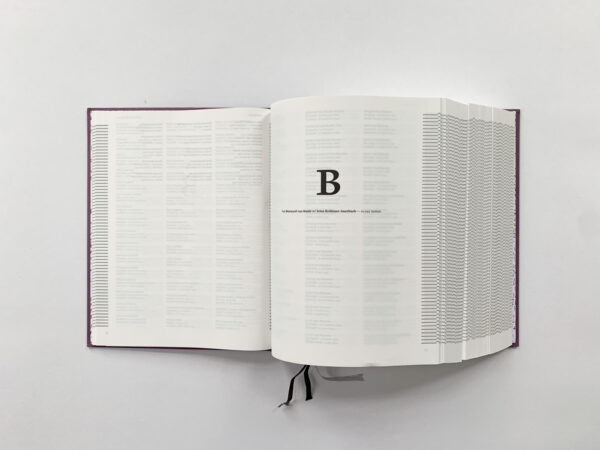De 102.000 namen
De 102.000 namen
people who were deported into concentration camps and murdered during the Second World War. It is the artist’s most complete version after years of research, although this version is not finished and there is a chance it never will be. Although “unfinished” we believe it is important in the selection because there is nevertheless a finality to it. In our selection, it demonstrates that the medium of a book can suit many purposes, like the important role of historical commemoration. We feel this is a book of monumental beauty. Its carefully considered choice of purpleas the only color used in the entire document creates an elegant and singularly appropriate look for an event of such gravity. The conceptual choice of lines ensures that the different names become one story and their placement on the left and right side of the pages creates a continuous narrative. The fragile and thin paper contributes to the grief of this tragedy. The striped bars on the outsides of the pages refer, in our view, to a way of commemorations that are also used in architecture with, for example, stone blocks. This simple but very prominent design makes this book into a monumental object that simply needs to exist.
- Auteur
- Herinneringscentrum Kamp Westerbork
- Prijs
- €75,00
- ISBN
- 978 90 24419 73 9
- Uitgever / Opdrachtgever
- Wilco Art Books, Amersfoort
- Ontwerper(s)
- René Van der Vooren, Amsterdam
- Drukkerij
- Wilco Art Books, Amersfoort
- Lithograaf
- Boom uitgevers Amsterdam
- Materiaal
- 50gsm Dundruk Prima Page, 140gsm HV Offset (wit)
- Bindwijze
- Sewn bound, hardcover
people who were deported into concentration camps and murdered during the Second World War. It is the artist’s most complete version after years of research, although this version is not finished and there is a chance it never will be. Although “unfinished” we believe it is important in the selection because there is nevertheless a finality to it. In our selection, it demonstrates that the medium of a book can suit many purposes, like the important role of historical commemoration. We feel this is a book of monumental beauty. Its carefully considered choice of purpleas the only color used in the entire document creates an elegant and singularly appropriate look for an event of such gravity. The conceptual choice of lines ensures that the different names become one story and their placement on the left and right side of the pages creates a continuous narrative. The fragile and thin paper contributes to the grief of this tragedy. The striped bars on the outsides of the pages refer, in our view, to a way of commemorations that are also used in architecture with, for example, stone blocks. This simple but very prominent design makes this book into a monumental object that simply needs to exist.
- Auteur
- Herinneringscentrum Kamp Westerbork
- Prijs
- €75,00
- ISBN
- 978 90 24419 73 9
- Uitgever / Opdrachtgever
- Wilco Art Books, Amersfoort
- Ontwerper(s)
- René Van der Vooren, Amsterdam
- Drukkerij
- Wilco Art Books, Amersfoort
- Lithograaf
- Boom uitgevers Amsterdam
- Materiaal
- 50gsm Dundruk Prima Page, 140gsm HV Offset (wit)
- Bindwijze
- Sewn bound, hardcover



